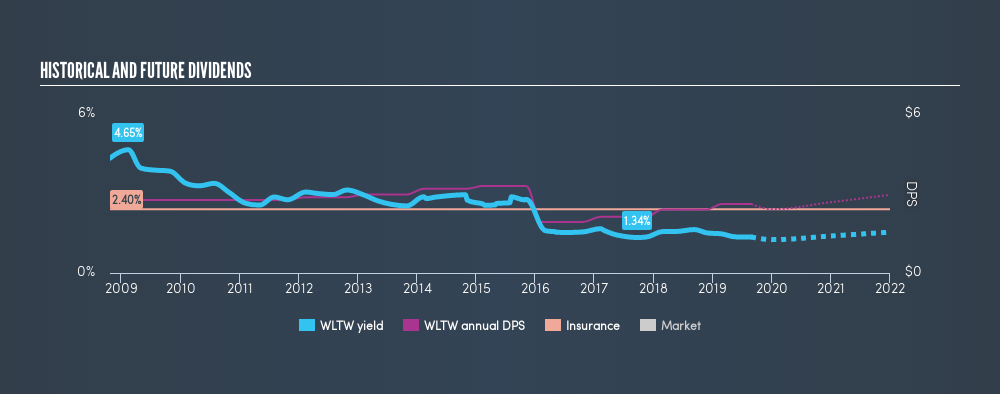- United States
- /
- Insurance
- /
- NasdaqGS:WTW
What To Know Before Buying Willis Towers Watson Public Limited Company (NASDAQ:WLTW) For Its Dividend

Could Willis Towers Watson Public Limited Company (NASDAQ:WLTW) be an attractive dividend share to own for the long haul? Investors are often drawn to strong companies with the idea of reinvesting the dividends. Unfortunately, it's common for investors to be enticed in by the seemingly attractive yield, and lose money when the company has to cut its dividend payments.
A 1.4% yield is nothing to get excited about, but investors probably think the long payment history suggests Willis Towers Watson has some staying power. The company also bought back stock equivalent to around 1.4% of market capitalisation this year. Some simple research can reduce the risk of buying Willis Towers Watson for its dividend - read on to learn more.
Explore this interactive chart for our latest analysis on Willis Towers Watson!

Payout ratios
Dividends are usually paid out of company earnings. If a company is paying more than it earns, then the dividend might become unsustainable - hardly an ideal situation. Comparing dividend payments to a company's net profit after tax is a simple way of reality-checking whether a dividend is sustainable. Looking at the data, we can see that 19% of Willis Towers Watson's profits were paid out as dividends in the last 12 months. We like this low payout ratio, because it implies the dividend is well covered and leaves ample opportunity for reinvestment.
Dividend Volatility
One of the major risks of relying on dividend income, is the potential for a company to struggle financially and cut its dividend. Not only is your income cut, but the value of your investment declines as well - nasty. Willis Towers Watson has been paying dividends for a long time, but for the purpose of this analysis, we only examine the past 10 years of payments. The dividend has been cut by more than 20% on at least one occasion historically. During the past ten-year period, the first annual payment was US$2.76 in 2009, compared to US$2.60 last year. Dividend payments have shrunk at a rate of less than 1% per annum over this time frame.
A shrinking dividend over a ten-year period is not ideal, and we'd be concerned about investing in a dividend stock that lacks a solid record of growing dividends per share.
Dividend Growth Potential
With a relatively unstable dividend, it's even more important to evaluate if earnings per share (EPS) are growing - it's not worth taking the risk on a dividend getting cut, unless you might be rewarded with larger dividends in future. Earnings have grown at around 3.3% a year for the past five years, which is better than seeing them shrink! Growth has been hard to come by. On the plus side, the dividend payout ratio is low and dividends could grow faster than earnings, if the company decides to increase its payout ratio.
Conclusion
When we look at a dividend stock, we need to form a judgement on whether the dividend will grow, if the company is able to maintain it in a wide range of economic circumstances, and if the dividend payout is sustainable. Firstly, we like that Willis Towers Watson has a low and conservative payout ratio. Second, earnings per share have been essentially flat, and its history of dividend payments is chequered - having cut its dividend at least once in the past. In summary, we're unenthused by Willis Towers Watson as a dividend stock. It's not that we think it is a bad company; it simply falls short of our criteria in some key areas.
Earnings growth generally bodes well for the future value of company dividend payments. See if the 12 Willis Towers Watson analysts we track are forecasting continued growth with our free report on analyst estimates for the company.
If you are a dividend investor, you might also want to look at our curated list of dividend stocks yielding above 3%.
We aim to bring you long-term focused research analysis driven by fundamental data. Note that our analysis may not factor in the latest price-sensitive company announcements or qualitative material.
If you spot an error that warrants correction, please contact the editor at editorial-team@simplywallst.com. This article by Simply Wall St is general in nature. It does not constitute a recommendation to buy or sell any stock, and does not take account of your objectives, or your financial situation. Simply Wall St has no position in the stocks mentioned. Thank you for reading.
About NasdaqGS:WTW
Willis Towers Watson
Operates as an advisory, broking, and solutions company worldwide.
Reasonable growth potential with adequate balance sheet.
Similar Companies
Market Insights
Community Narratives



